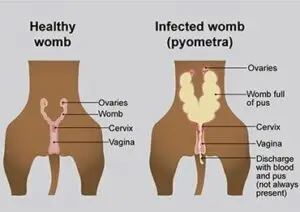Cause:
Pyometra is a serious condition caused by hormonal changes that occur during the normal breeding cycle of an intact female.
During a dog’s oestrus (heat cycle) when the cervix is more relaxed, bacteria (most commonly, E. coli) can ascend from the vagina into the uterus. Then, as the female enters the dioestrus stage after a heat cycle, the hormone progesterone increases which causes the uterus lining to thicken. After numerous heat cycles of thickening and thinning, the lining can develop cysts which leads to fluid secretions, making it easier for bacteria to grow.
As the uterus fills with bacteria and pus, (pyometra) the toxins formed by the bacteria can leak from the uterus and enter the bloodstream (septicaemia), leading to life-threatening effects.
Typically, this all happens about 4-6 weeks after the heat cycle is seen.
Clinical Signs:
The severity of signs of a pyometra will depend on whether the cervix (entrance into the uterus) is open or closed. More severe signs of illness will occur when the cervix is closed, because the pus remains trapped in the body.
Signs of Pyometra include:
- Lethargy
- Poor appetite
- Increase drinking and urination
- Distended or painful belly
- Vomiting
- Fever
- Weakness or collapse
Vaginal discharge that is cream-coloured or bloody is the primary sign when the cervix is open, but may not be seen if the cervix is closed.
Diagnosis:
Your veterinarian will suspect pyometra based on the history and physical exam, such as a history of a recent heat, unwell and a discharge.
They will commonly also use any of the following tests to confirm a diagnosis:
- Ultrasound or X-rays to identify an enlarged uterus
- Blood work (to ID infection)
- Urine sample
- Vaginal cytology
Treatment:
Pyometra is a life-threatening disease that usually leads to shock and death from the infection overwhelming the body. It requires urgent veterinary attention.
Pyometra is best treated with surgery to remove the ovaries and uterus (spey). The surgery for a pyometra is more complicated than a spey in a healthy dog or cat. They require intensive care and treatment for sepsis, dehydration and shock, including IV fluids and anti-biotics. There is a risk that the patient may not survive the surgery or immediate post-op period.

Medical management (to spare the uterus) involves injections of the hormone prostaglandin, fluids and antibiotics. However, it is generally discouraged except for specific cases, such as a young, valuable breeding dog. It is not a viable option for a critically ill dog or one with a closed pyometra. IN addition, once a pet has had pyometra, they are much more likely to develop it on future heats, and they may never breed successfully due to the damage to the uterus. Other issues with medical management include; the time taken to see a response, the fact that some animals don’t respond and still require surgery, and the potential side effects, including panting, drooling, diarrhoea, vomiting and even the potential rupture of the uterus, which could be life-threatening.
Outcome:
Prognosis for recovery depends on how early the disease is diagnosed and whether the pyometra is open or closed. Both of these impact how septic the patient is when it goes to surgery, which ultimately impacts the survival at surgery. Once surgery has been performed and the patient has recovered there should be little to no long lasting effects from the disease.
Prevention:
Pyometra is entirely preventable if a dog or cat is spayed to remove the ovaries and uterus. Having your pet speyed while young and healthy is safer and less costly than experiencing an emergency pyometra surgery, which is just one of the reasons we recommend speying of all pets not intended for breeding.




